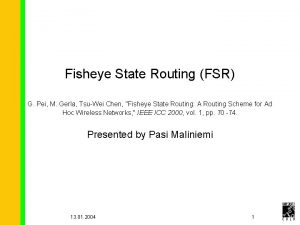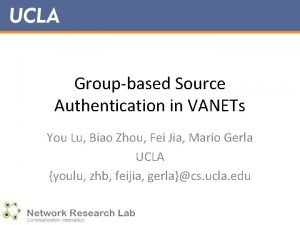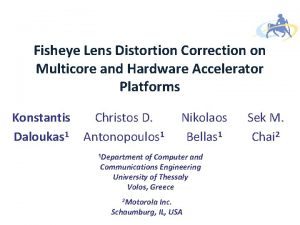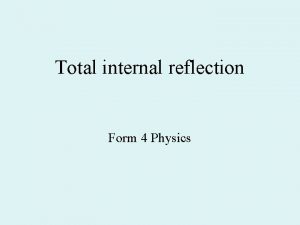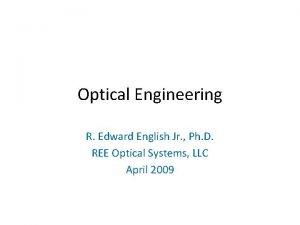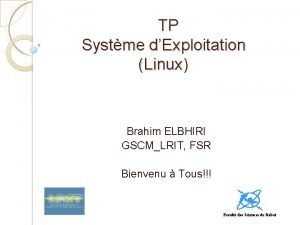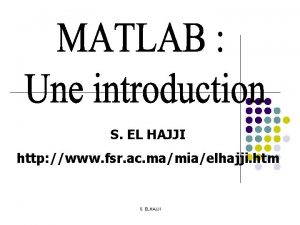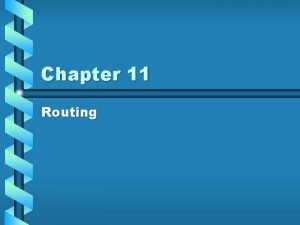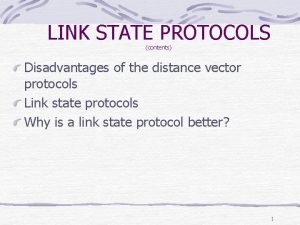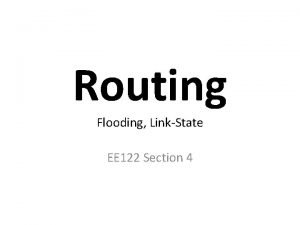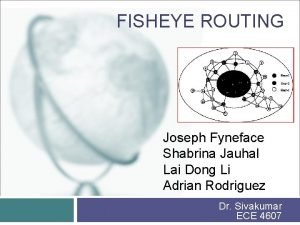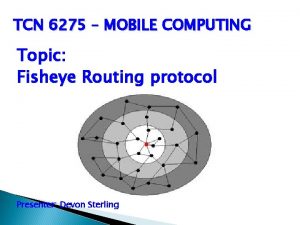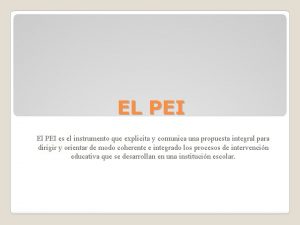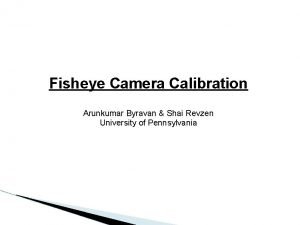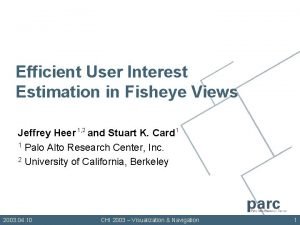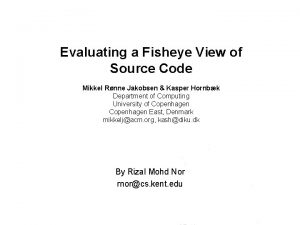Fisheye State Routing FSR G Pei M Gerla














- Slides: 14

Fisheye State Routing (FSR) G. Pei, M. Gerla, Tsu-Wei Chen, "Fisheye State Routing: A Routing Scheme for Ad Hoc Wireless Networks, " IEEE ICC 2000, vol. 1, pp. 70 -74. Presented by Pasi Maliniemi 13. 01. 2004 1

Presentation outline Fisheye vision Fisheye State Routing (FSR) Routing technique comparison FSR Simulation Results FSR - Summary References 13. 01. 2004 2

Fisheye vision • Fish do have 360° (or almost) vision. • Fishes (and humans) do have a higher concentration of optic nerves close to they focal point than elsewhere in they eye. • As a result fisheye captures with high detail the points near the focal point 13. 01. 2004 3

Fisheye vision Fisheye View of Polaris. Dennis Anderson (2002) 13. 01. 2004 4

Fisheye State Routing (FSR) • For routing this approach translates into an accurate information in the immediate neighborhood of a node and less detail as the distance increases. • FSR is similar to link state (LS) routing in that each node maintains a view of the network topology with a cost for each link. • In LS routing link state packets are flooded into the network whenever a node detects a topology change. 13. 01. 2004 5

Fisheye State Routing (FSR) • In FSR nodes maintain a topology table (TT) based on the up-to-date information received from neighboring nodes and periodically exchange it with their local neighbors. • For large networks in order to reduce the size of the routing update messages the FSR technique uses different exchange periods for different entries in the routing table. • Relative to each node the network is divided in different scopes. 13. 01. 2004 6

Scopes of FSR 33 3 8 5 2 14 6 15 36 24 4 7 13 18 12 26 30 31 13. 01. 2004 19 11 16 25 9 1 17 23 10 21 22 20 29 35 27 28 32 34 1 hop 2 hops 3 or more hops 7

Routing technique comparison 13. 01. 2004 8

Message Reduction in FSR TT 0: {1} 1: {0, 2, 3} 2: {5, 1, 4} 3: {1, 4} 4: {5, 2, 3} 5: {2, 4} HOP 1 0 1 1 2 2 Entries in black are exchanged more frequently 0 1 3 2 4 5 13. 01. 2004 TT 0: {1} 1: {0, 2, 3} 2: {5, 1, 4} 3: {1, 4} 4: {5, 2, 3} 5: {2, 4} HOP 2 1 2 0 1 2 HOP 2 2 1 1 0 1 9

Simulation Results 13. 01. 2004 10

Simulation Results 13. 01. 2004 11

FSR - Summary • Routing table entries for a given destination are updated, i. e. exchanged with the neighbors, with progressively lower frequency as distance to destination increases • The further away the destination, the less accurate the route • As a packet approaches destination, the route becomes progressively more accurate 13. 01. 2004 12

FSR - Summary • Benefits ° Scales well to large network sizes ° Control traffic overhead is manageable • Problems ° Route table size still grows linearly with network size ° As mobility increases routes to remote destinations become less accurate ° What happens if the target node is out of the scope of all nodes in the source nodes scope 13. 01. 2004 13

References G. Pei, M. Gerla, Tsu-Wei Chen, "Fisheye State Routing: A Routing Scheme for Ad Hoc Wireless Networks, " IEEE ICC 2000, vol. 1, pp. 70 -74. Carlos Pomalaza-Ráez, Ad Hoc Networks - course material, University of Oulu 13. 01. 2004 14
 Pei wei polaris
Pei wei polaris Mario gerla
Mario gerla Fisheye lens target
Fisheye lens target Fisheye view total internal reflection
Fisheye view total internal reflection Sunex super fisheye
Sunex super fisheye Comparison of clock routing and power routing
Comparison of clock routing and power routing Flood routing lecture notes
Flood routing lecture notes Static routing and dynamic routing
Static routing and dynamic routing Hydrologic routing and hydraulic routing
Hydrologic routing and hydraulic routing Gas turbine protection list
Gas turbine protection list Linux fsr
Linux fsr Www.fsr.ac.ma
Www.fsr.ac.ma Objectives of routing
Objectives of routing Advantages and disadvantages of distance vector routing
Advantages and disadvantages of distance vector routing Link state routing protocol
Link state routing protocol
